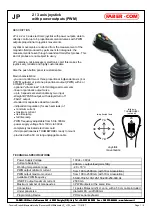
CN20, CN34 SERIES DAMPER ACTUATOR FOR MODULATING AND FLOATING CONTROL
EN0B-0341CH33 R0803A
4
0 0.24
0
50
100
5.0
10.0
9.76
upper dead band (9.76 to 10.0 V)
control signal (V)
final position of sha
ft adapter
(% of max. stroke)
range of proportional
actuator movement
(0.24 to 9.76 V)
lower dead band (0 to 0.24 V)
Fig.4. Final actuator position in dependence upon control
signal (example selection setting of 0...10 V)
0
0
50
100
5
10
feedback signal (V)
cur
rent position of
sh
af
t
adapter (%
o
f max.
stroke)
Fig.5. Feedback signal in dependence upon current
position of actuator (example selection switch setting of
0...10 V)
Adaption
Adaption is a function in which the actuator re-maps its feed-
back signal and control signal in accordance with repositioned
mechanical end limits (see Fig.6) and thus recognizes their
new positions.
fin
al po
si
tion o
f
act
uator (% of max
.)
final p
osi
tion
of ac
tuator (degrees
)
0
95
0
10.0
control signal (volts)
new position of UPPER
mechanical end limit
new position of LOWER
mechanical end limit
bef
or
e
ad
ap
tio
n
afte
r a
dap
tion
0
(before)
100
(before)
0
(after)
100
(after)
Fig.6. Adaption (selection switch set to "0...10 V")
Adaption will be carried out only
when:
•
Modulating models only, such as CN7220A2007,
CN7234A2008, etc,
•
actuator is wired in modulating mode (see Fig. A1)
•
the control signal’s value rises up into the upper dead
band (i.e to more than the max. control signal minus
0.14V) or drops down into the lower dead band (i.e to less
than the min. control signal plus 0.14V), and if the shaft
adapter can remain at the respective (upper or lower)
mechanical end limit at least 3 seconds, the actuator will
recognize the new position automatically, and auto-
adaption is happened (see Fig. 4).
Sleep Mode
When actuator reaches end stop or any obstacles blocking its
running, it will fall into sleep mode automatically. Actuator will
periodically start up and try to resume running, which will save
energy significantly through whole service life.
Overriding
An override is a condition in which a 24 V signal is applied to
terminal 4 of an actuator in the modulating mode, thus
causing the actuator to ignore the control signal at terminal 3,
whereupon it will instead move to a position of 0% of its
maximum stroke. It would be the most left side [0/2~10V
mode] or most right side [10~0/2 V mode] (see Table 3).
Feedback
If correspondingly wired (see A1), the actuator provides, via
terminal 5, a feedback signal(0/2~10V) proportional to the
actual position of the actuator (see Fig. 5).
Dip Switches
The actuator is equipped with two dip switches (only switch 1
selectable) accessible after removing the access cover (see
Fig. 7).
1: (U) VOLTAGE CONTROL
O
N
1
2
O
N
1
2
2: RESERVED
1: (mA) CURRENT
2: RESERVED
O
N
1
2
Fig.7. Dip switches (view with PCB at bottom)


























